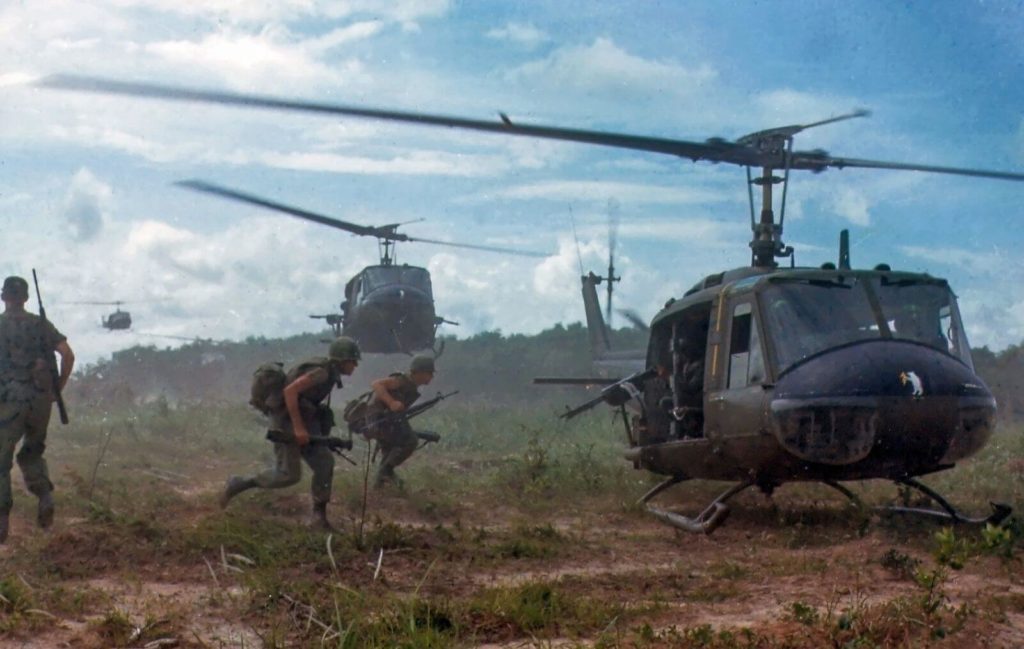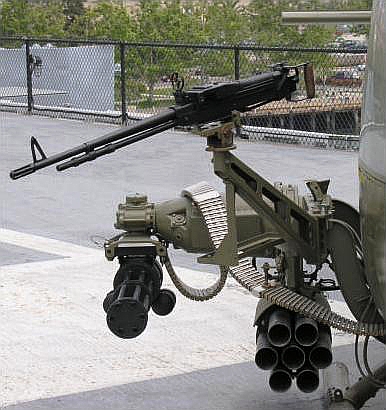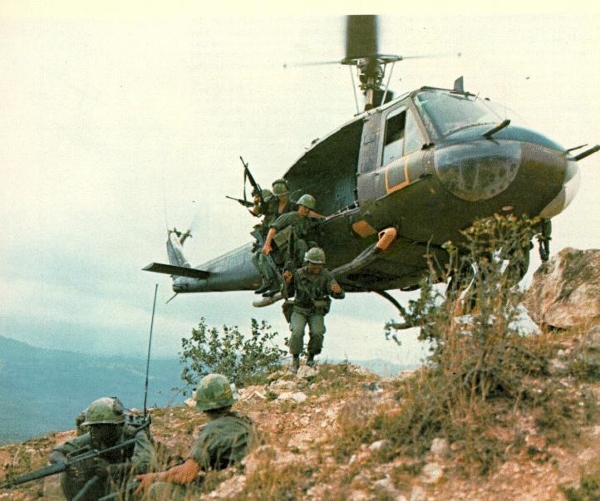
|
Bell UH-1 Iroquois |
 |
||||||||
|---|---|---|---|---|---|---|---|---|---|---|
 |
 |
 |
 |
 |
 |
 |
 |
 |
 |

|
|
Many different types of aircraft fought in the Vietnam War, but the aircraft that most symbolized the war was the Huey. From general support, MEDEVAC, gunship, air assault, cargo transport, search and rescue, electronic warfare, and later, ground attack, the Huey was the workhorse that served many roles. As a result of the Vietnam War, the Huey has become the most recognizable helicopter in the world. More than 16,000 Hueys were produced worldwide, of which about 7,000 played a role in Vietnam.
The initial designation of HU-1A (helicopter utility) led to its nickname, “Huey.” It was developed from the Model 201 which was a modified Model 47 (XH-13F) helicopter using a Continental CAE XT51-T-3 turboshaft engine, replacing the 280 hp (210 kW) Lycoming 6-cylinder piston engine. The Bell Model 204, designated the XH-40, would become the Huey that was designed to meet a 1952 US Army requirement for a medical evacuation and utility helicopter. Trials began in 1955 and it made its inaugural flight on October 2, 1956. The Huey was first used by the military for trials in 1959 and in March 1960, the Army awarded Bell a contract for 100 aircraft. In 1962, the Huey went into tri-service production under a Department of Defense unified designation as the UH-1. The Huey was a relatively basic aircraft with no complicated systems that consisted of an engine, a rotor system, and a fuselage. The XH-40 prototype was powered by a 700 shaft horsepower (shp) (520 kW) Lycoming T53-L-1A engine. The first 14 production models were powered by the same engine, but there were complaints that the aircraft was underpowered and later models were upgraded to the 960 shp (720 kW) T53-L-5 engine derated to 770 shp (570 kW). The UH-1B Lycoming T53-L-5 engine's power was increased to 960 shp (720 kW) and later models were powered by a 1,100 shp (820 kW) T53-L-11 engine. The B model also had a longer cabin that could accommodate a crew of eight or three stretchers and a medical attendant. Weapon attach points and preinstalled wiring for gunnery was also added. The first UH-1Bs arrived in South Vietnam in May 1963. Development on the UH-1C began in 1960 to create an aircraft large enough to accommodate all weapons in use then, or in development. UH-1D Hueys could be armed with M60D door guns, quad M60Cs on the M6 aircraft armament subsystem, 20mm cannon, 2.75 inch rocket launchers, 40 mm grenade launcher in M5 helicopter chin-turret, and up to six NATO Standard AGM-22B (formerly SS-11B) wire-guided anti-tank missiles on the M11 or M22 guided missile launcher. The UH-1D could also be armed with M60D 7.62mm or M213 .50 Caliber pintle-mounted door guns on the M59 armament subsystem.

The UH-1C was powered by the same T53-L-11 engine used on the late model UH-1B. A new rotor system was developed to increase airspeed and increase maneuverability. The tail boom was lengthened with a wider chord vertical fin and larger synchronized elevators. A hydraulic system was also introduced for the purpose of redundancy and the engine inlet filter system was improved to handle dusty conditions. The fuel load was increased to 242 gallons (920 liters) and gross weight increased to 9,500 lb (4,310 kg). The UH-1D was based on Bell’s commercial Model 405. It was powered by the same T53-L-11 engine as the UH-1C and had a larger cabin that could accommodate a crew of twelve or six stretchers. The YUH-1D prototype first flew in August 1961 and production models began delivery to the US Army in August 1963. The UH-1E was a modified B model created for the United States Marine Corps (USMC). The major changes were corrosion resistant all aluminum construction, radios compatible to USMC frequencies, a rotor-brake for shipboard use and a roof mounted rescue hoist. The first models were powered with a 1,100 shp (820 kW) Lycoming T53-L-11 engine and later models were upgraded to a 1,400 shp (1,000 kW) Lycoming T53-L-13 engine.

The UH-1F was a US Air Force Model powered by a General Electric 1,250 hp (932 kW) T58 turboshaft engine. The USAF had a large inventory of these engines for its Sikorsky HH-3 Jolly Green Giant helicopters and it wanted to standardize engines for both aircraft. The UH-1F had a shorter cabin than the B model, but the longer tail boom, rotor, and transmission of the UH-1D. The only external difference was the engine exhaust exits to the right, instead of aft as on Hueys powered by T53s. The Model 205, UH-1H, was a stretched version of the UH-1B and could accommodate up to 15 passengers or six stretchers and a medical attendant. The sliding door on the earlier models was replaced with larger doors with two windows. The doors could easily be removed in a “doors off” configuration. The original rotor was 44 feet (13.4 m) and was increased to 48 ft (14.6) with a wider chord of 21 in (53 cm). The tail was also lengthened to accommodate the longer main rotor. The pitot tube was relocated from the nose to the cockpit roof to prevent damage during landing. It was powered by a 1,100 shp (820 kW) Lycoming T53-L-9 engine and in 1966 the engine was upgraded to a 1,400 shp (1,000 kW) Lycoming T53-L-13 engine. The gross weight remained at 9,500 lb (4,310 kg). The Bell Model 212, UH-1N Twin Huey was first ordered by Canadian Forces and it made its inaugural flight in April, 1969. It had a capacity for fourteen passengers and one pilot. It was powered a PT6T-3/T400 Turbo Twin Pac consisting of two Pratt & Whitney Canada PT6 turboshaft engines. The Twin Pac produced 1,800 shp (1,342 kW) and 900 shp (671 kW) on one engine for 30 minutes with a full load.
 US Navy UH-1N Twin Huey.
US Navy UH-1N Twin Huey.
A signature component of the Huey’s rotor was the gyroscopic "Stabilization Bar" on top of the main rotor. The stabilizer bar was a weighted unit mounted across the main rotor. It provided a dampening action to provide a measure of stability. The USMC modified a large number of their UH-1Ns with a Stability Control Augmentation System (SCAS) which provided servo inputs to the rotor head to help stabilize the aircraft during flight. This modification replaced the gyroscopic "Stabilization Bar" on top of the main rotor head with a computer system for stability. The last Hueys were produced in 1976 and provided outstanding service for the US Army for almost thirty years. Finally retired, it was replaced by the Sikorsky UH-60 Blackhawk. |
| Specifications: | |
|---|---|
| Bell UH-1D Iroquois | |
| Dimensions: | |
| Rotor span: | 48 ft 0 in (14.60 m) |
| Length: | 57 ft 1 in (17.40 m) |
| Height: | 14 ft 5 in (4.40 m) |
| Weights: | |
| Empty: | 5,215 lb (2,365 kg) |
| Max Gross: | 9,500 lb (4,310 kg) |
| Performance: | |
| Maximum Speed: | 135 mph (220 km/h) |
| Cruise Speed: | 125 mph (205 km/h) |
| Rate of Climb: | 1,755 ft/min (534 m/min) |
| Service Ceiling: | 19,390 ft (5,910 m) |
| Range: | 315 miles (510 km) |
| Powerplant: | |
| One Lycoming T53-L-11 turboshaft, 1,100 shp (820 kW). | |
| Armament: | |
|
2x 7.62 mm M60 machine gun, or 2x 7.62 mm GAU-17/A machine gun or 2x 7-round or 19-round 2.75 in (70 mm) rocket pods. | |
Endnotes:
|
1. Stephen Harding. U. S. Army Aircraft Since 1947. London: Airlife Publishing Ltd., 1990. 39-44. |
©Larry Dwyer The Aviation History On-Line Museum.
All rights reserved.
Created November 4, 2009. Updated September 22, 2024.